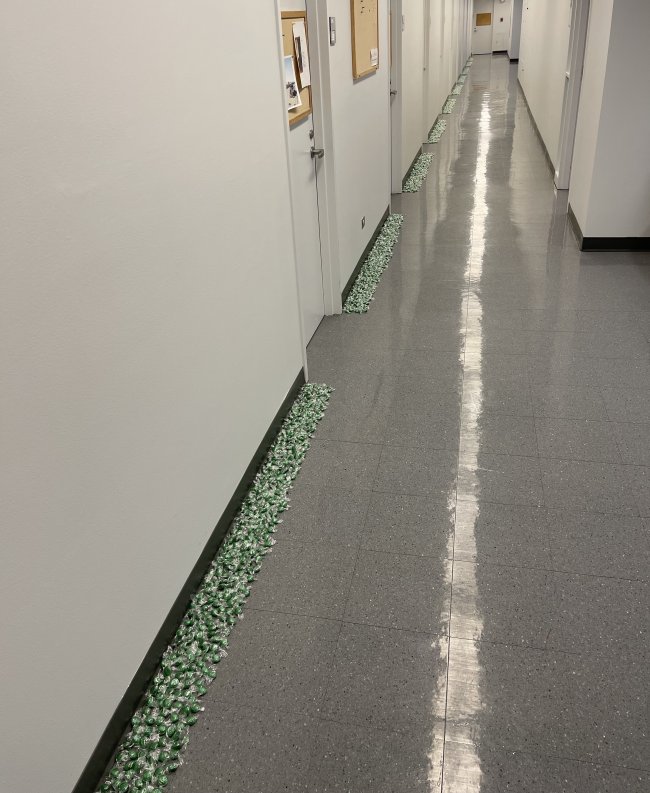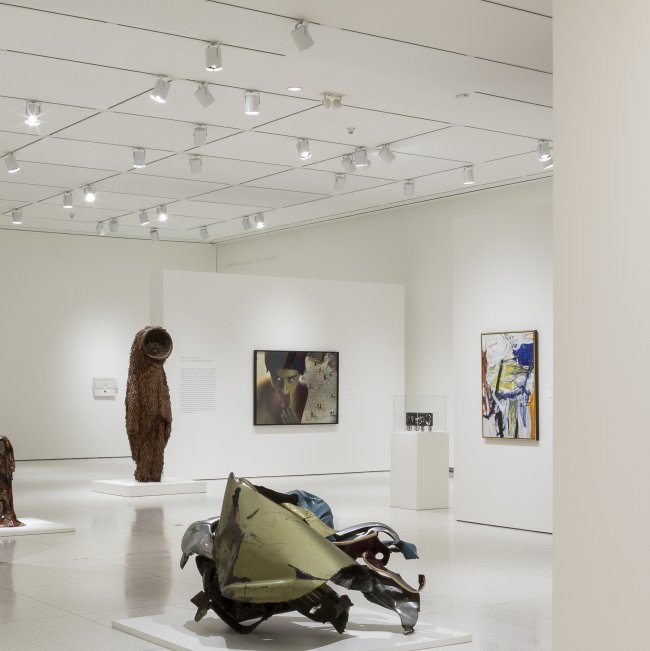Collections & Exhibitions
Architecture on Campus

The campus was originally planned in the early 1890s, at the same time as the celebrated World’s Columbian Exposition in the lakefront Jackson Park, a few blocks away. Although the Exposition was classical and the campus plan was Gothic, both exemplified a new ideal of urban coordination termed group planning, with stylistically consistent buildings symmetrically arranged around central spaces and deferring to a dominant central monument. In the context of Victorian America, such Beaux-Arts inspired coordination was received as a revelation.
The campus plan, by Henry Ives Cobb, an architect who designed the buildings of many of Chicago’s public and cultural institutions, guided the construction of the university’s central quadrangles until just after World War II, when one of the trustees attended a lecture by the dean of Harvard’s architecture school. Dean Hudnut lambasted the university for ignoring the lessons of modernist architecture and planning, and ultimately persuaded the trustees to embrace a different approach. Since then, the University has expanded outward from the central quads, testing new ideas for architectural design and siting patterns with the aid of leading architects, from Eero Saarinen, Ludwig Mies van der Rohe, and Walter Netsch of Skidmore Owings and Merrill, in the 1950s to 1970s, to Jeanne Gang, Tod Williams and Billie Tsien, and Diller Scofidio + Renfro, in the present.
Art at the David Rubenstein Forum
A monument to the University of Chicago’s academic rigor, the David Rubenstein Forum was constructed to provide a fitting space for distinguished guests to convene and collaborate on projects of inquiry. Designed by renowned design firm Diller Scofidio + Renfro, the Forum’s modular and stacked façade provides picturesque views of Hyde Park surrounds and Chicago’s skyline.
To complement the state-of-the-art facility, art programming was created to support the Forum’s overarching mission of establishing the University of Chicago as a premier intellectual destination for the exchange of ideas. Art at the David Rubenstein Forum installs artworks throughout convening spaces at the Forum. The inaugural program in 2020 showcased University of Chicago Trustee Kenneth C. Griffin’s art collection in conversation with Forum namesake, David M. Rubenstein’s collection of rare historical documents. Artworks displayed included an interactive teamLab digital work, a Willem de Kooning painting and the Declaration of Independence.
Arts Incubator

Located on Garfield Boulevard in Washington Park, the Arts Incubator is a space for artist residencies, arts education, and community-based arts projects, as well as exhibitions, performances, and talks. Founded by artist and DoVA faculty member Theaster Gates and operated by the University of Chicago’s Arts + Public Life initiative, the Arts Incubator presents several exhibitions each year in its main gallery space and a number of smaller exhibitions in its Flex Space. All exhibitions are free and open to the public.
Booth Art Collection

The Booth School of Business Art Collection is on permanent display at the Charles M. Harper Center, designed by Uruguayan architect Rafael Viñoly. Since 2005, a group of five people—Suzanne Deal Booth, Susanne Ghez, Canice Prendergast, James Rondeau, and Dean Valentine—has collectively chosen works of international contemporary art to build this collection. Today, it includes over four hundred works by one hundred and twenty five artists and continues to grow. Artists represented include Paul Chan, Tacita Dean, Seydou Keïta, Jutta Koether, Les Levine, Rivane Neuenschwander, Adam Pendleton, Raymond Pettibon, and Giuseppe Penone. Rather than following a single theme, it reflects the mission of Booth and the University of Chicago by including works that may be conceptually challenging but raise important questions for students, staff, and faculty.
CWAC Exhibitions

Growing from a deep appreciation for object-based learning and a desire to galvanize curatorial endeavors, CWAC Exhibitions (CWAC Exh) presents student- and course-curated opportunities for exhibitions at the Cochrane-Woods Art Center, home of the Department of Art History. CWAC Exh programming draws from the Joel Snyder Materials Collection (JSMC), artwork by student artists, and other objects safe to display in our context. For more information, please review the Guide to Preparing a Proposal.
Institute for the Study of Ancient Cultures, West Asia and North Africa

The Institute for the Study of Ancient Cultures, West Asia & North Africa (ISAC) was founded in 1919 by James Henry Breasted with the financial support of John D. Rockefeller Jr., and was originally envisaged as a research laboratory for the investigation of the early human career that would trace humankind’s progress from the most ancient days of West Asia and North Africa. The goal of ISAC is to be the world’s leading center for the study of ancient Near Eastern civilizations by combining innovation in theory, methodology, and significant empirical discovery with the highest standards of rigorous scholarship.
The ISAC Museum opened to the public in 1931. The majority of the collections came from its expeditions in the West Asia and North Africa during the 1920s, 1930s, and 1940s. A major reinstallation of the Museum took place in the 1990s and early 2000s. Permanent collections and special exhibits focused on the ancient Near East are valuable resources for teaching and research.
ISAC and the Department of Art History’s Center for the Art of East Asia jointly own and use 3D scanning equipment and software for digital research projects. ISAC Museum curators occasionally teach classes in art history.
Logan Exhibitions

Logan Center Exhibitions presents international contemporary art programming at the Logan Center Gallery and throughout the Reva and David Logan Center for the Arts at the University of Chicago. Reflecting the spirit of inquiry at the university, Logan Center Exhibitions focuses on open, collaborative, and process-based approaches to cultural production. Working closely with artists, students, scholars, and community members, Logan Center Exhibitions presents innovative exhibitions by emerging and established artists, supports ambitious new commissions and research projects, disseminates knowledge through publications, and facilitates connections through talks and other public programs. Each spring quarter, the Logan Center Gallery exhibits the work of graduating college and MFA students.
Neubauer Collegium Exhibitions
Neubauer Collegium Exhibitions present both historical and contemporary art in the context of the interdisciplinary research conducted through the Neubauer Collegium for Culture and Society. Visual arts, media, and material culture are central to the intellectual life of the Neubauer Collegium, helping to rethink the meaning of art and the contributions it can make to scholarly inquiry. Exhibitions are curated to meet a range of objectives. Some shows complement research projects supported by the Neubauer Collegium; others combine concerns common to multiple projects within a group exhibition; and still others offer a singular vision and voice that resonates with the alternative, collaborative research mission of the Neubauer Collegium.
Public Art on Campus

The Campus and Public Art Collection comprises several thousand objects—including paintings, photographs, sculptures, and historic artifacts—that can be found in and around nearly every building on campus. The most prominent public sculptures were researched and presented online by art history students as part of two courses on public art taught by Professor Christine Mehring. Whether Lorado Taft’s Fountain of Time (1922) or Henry Moore’s Nuclear Energy (1967), Wolf Vostell’s Concrete Traffic (1970) or Giuseppe Penone’s Ideas of Stone (2010), public art creates countless moments for spontaneous community building and conversation. It extends the intellectual life of the university beyond classrooms, libraries, and labs, into everyday spaces and experiences. The collection has inspired recent arts programming on campus, including Concrete Happenings and Nuclear Reactions, and prompted complex, collaborative conservation, including of Wolf Vostell’s Concrete Traffic and Jene Highstein’s Black Sphere.
Regenstein Library

The University of Chicago Library, one of the largest university collections in North America, holds over 12 million items in print, video, and digital format. In addition to the circulating collections, rare books ranging from Medieval illuminated manuscripts to contemporary artists’s books can be found in the Hanna Holborn Gray Special Collections Research Center, which also holds a substantial collection of photographs and archives. The Guide to Art History and Visual Arts provides an overview of resources in these areas. Beyond their research, faculty and students have used these collections for teaching and for curating exhibitions, for example “Concrete Poetry, Concrete Book" and “Paul B. Moses: Trailblazing Art Historian.”
The Art Reading Room on the 4th floor of Regenstein (room 420) houses a robust collection of East Asian art books and the Max Epstein Photographic Archive. The East Asian Collection, one of the finest in the country, is a major resource for faculty and graduate students in Asian art. The collection consists of over 530,000 volumes, including 340,000 volumes in Chinese, 170,000 volumes in Japanese, 18,000 in Korean, Manchu, Mongolian, and Tibetan.
The Renaissance Society

The Renaissance Society was founded in 1915 by University of Chicago faculty members as a laboratory of creative experimentation and a space of discovery for contemporary art. A non-collecting museum located on campus but an independent entity, it has been at the forefront of presenting artistic innovation from around the world for nearly 100 years. The Renaissance Society supports artists by commissioning new work and producing exhibitions, publications, and interdisciplinary public programs. At the center of all of the Renaissance Society’s offerings is the evolving question of what art is in the present moment, and what art can be.
Throughout its history “the Ren” has been known for presenting vital practices from across the world: the first US exhibition of Alexander Calder’s mobiles in 1934; the Chicago debuts of Bruce Nauman, Joseph Kosuth and Jenny Holzer in the 1970s and 80s; key solo exhibitions by Mike Kelley (1988), Isa Genzken (1992), Felix Gonzales-Torres (1994), Kerry James Marshall (1998), Joan Jonas (2004), Danh Vo (2012), and Nora Schultz (2014).
Today the Renaissance Society maintains this commitment to ambitious artistic experimentation, primarily through the production of new work, and to fostering a rigorous and interdisciplinary discourse around it. In addition to the exhibition program, the Ren hosts an eclectic range of concerts, performances, lectures, screenings, and readings.
The Smart Museum of Art

Facing the Department across a shared courtyard, the Smart Museum of Art is a site for rigorous inquiry and exchange that encourages the examination of complex issues through the lens of art objects and artistic practice.
Collections spanning many historical areas and geographic regions inform ambitious exhibitions that reflect our global world—both contemporaneously and across history. The Smart’s galleries and study room welcome hundreds of classes in art history and other fields each year, providing students with first-hand exposure to original works of art as an enhancement to their curriculum. Faculty and students, especially in art history, regularly collaborate on museum exhibitions and publications, often through the museum's Feitler Center for Academic Inquiry.
The Smart offers many opportunities for student involvement, whether through employment and internships throughout the museum or through participation in its many student-oriented social events.
